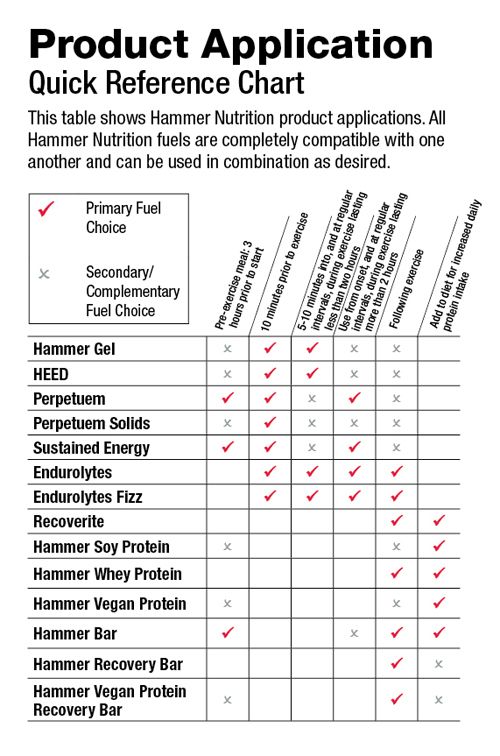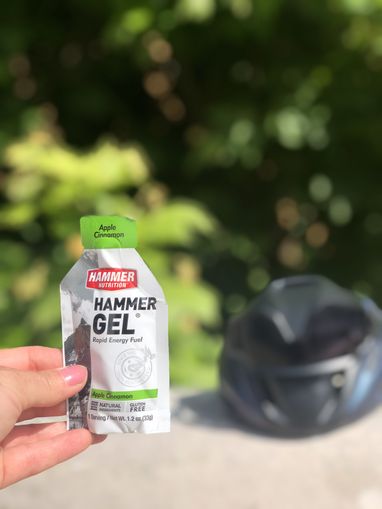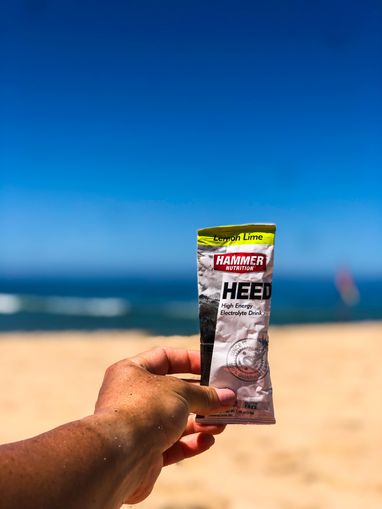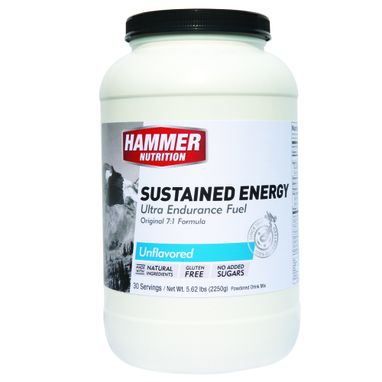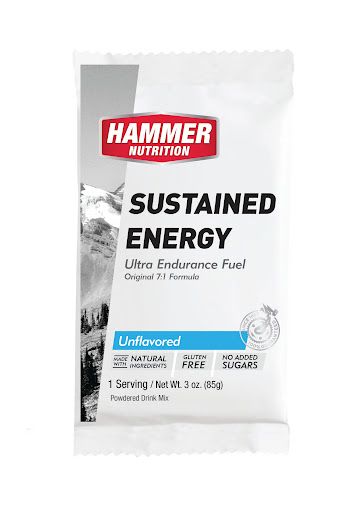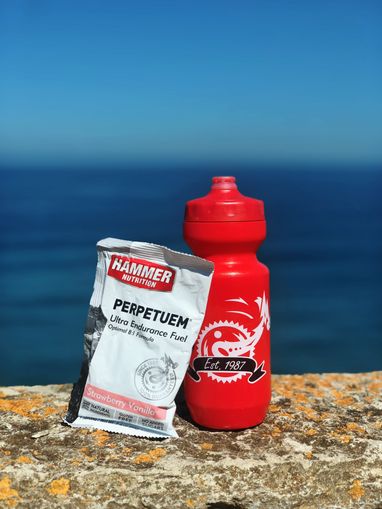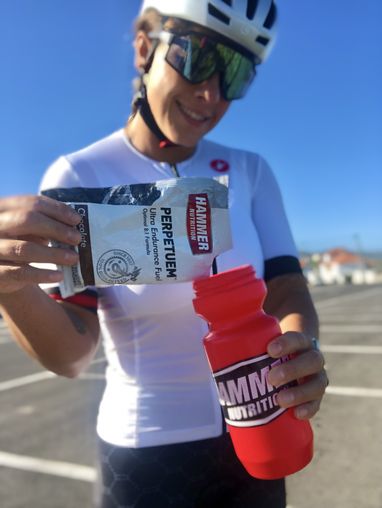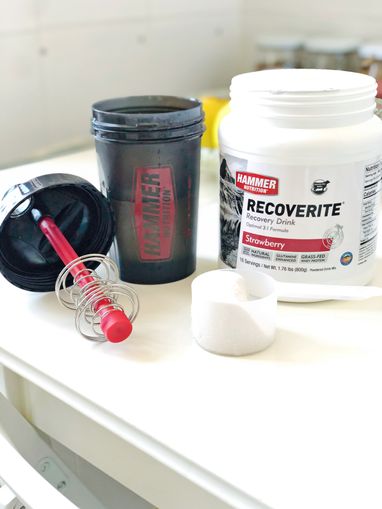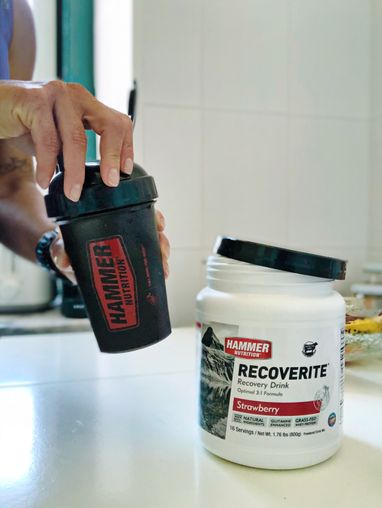THE HAMMER NUTRITION FUELS
By Steve Born
Steve's nearly three decades of involvement in the sports nutrition industry, as well as more than 20 years of independent research in nutritional fueling and supplementation, have given him unmatched familiarity with the myriad product choices available to athletes.
CALORIE/ENERGY SOURCES
We have four products in this category. The first two listed,
Hammer Gel
and
HEED
, have only carbohydrates as their energy source. Choose them for events lasting up to two hours, perhaps up to three hours on occasion, especially when the pace is fast and intense (75–85%+ MHR). The other two on the list,
Sustained Energy
and
Perpetuem
, contain protein also and other components for fueling longer exercise sessions.
ALL–CARB FUELS
Hammer Gel –A rapidly absorbed and assimilated source of complex carbohydrates in an easy-to-consume gel form (actually, a liquid of syrup-like consistency), providing smooth, consistent energy. Use Hammer Gel in the following ways:
-
As all or part of a pre-race meal
-
To allay hunger immediately before an event
-
As your sole source of calories in workouts/races lasting up to two hours, sometimes up to three hours in certain circumstances
-
As a part-time fuel during longer workouts and races (to supplement Hammer Nutrition’s protein-fortified fuels)
-
As part of your post-workout recovery nutrition
-
To add to Sustained Energy or Perpetuem for flavor
You can use Hammer Gel in your water bottle (it mixes completely in solution), in the Hammer Flask, in a one–serving pouch, or to flavor other products and foods. You can keep an extra pouch or flask in your pocket in case your planned fuel outlay in a race or training event comes up a bit short. To coin an oft–used phrase, “Don’t leave home without it!” As with all of the Hammer Nutrition fuels, Hammer Gel is made without added simple sugars or artificial colors, flavors, or sweeteners.
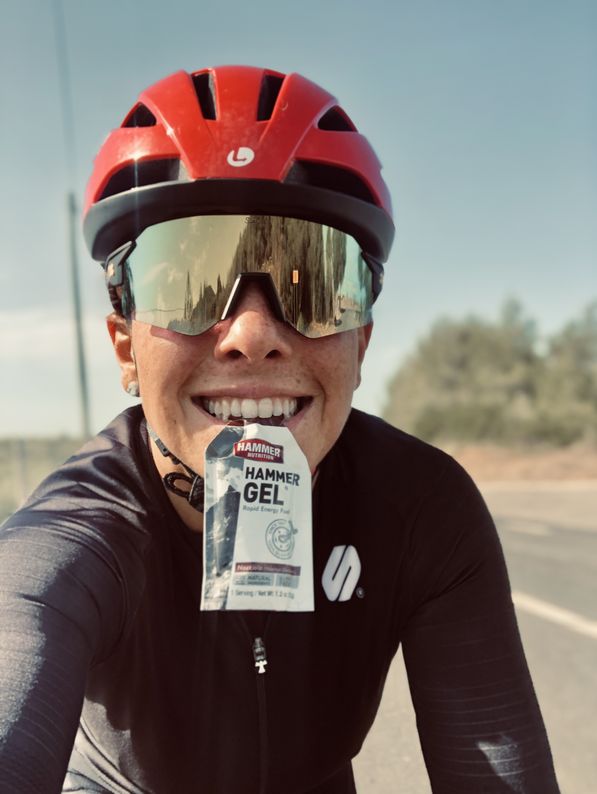
THE UNIQUE CARBOHYDRATE MAKEUP OF HAMMER GEL
Hammer Gel contains two sources of carbohydrates. The first one is a specific maltodextrin containing a unique saccharide profile that consists of an unusually large amount of pentasacharides, (5–sugar chain complex carbohydrate). This particular pentasaccharide has unique properties that allow for maximal conversion to energy. In addition, this maltodextrin is relatively low on the Dextrose Equivalent (DE) scale, which is beneficial because the lower the DE, the quicker it will exit the GI tract and cross the stomach lining, allowing it to be more readily available for energy production. The maltodextrin used in Hammer Gel has a DE of 18, whereas sucrose (table sugar), a sweetener found in many sports gels and drinks, has a DE of 100. Hammer Gel is highly absorbable, and readily available for the demands of both endurance and strength events.
The other carbohydrate source is the patented natural sweetener Energy Smart™, a combination of naturally occurring fruit based mono– and disaccharides plus specially developed medium and long chain dextrins derived from grain. The process of creating Energy Smart™ maintains the integrity of the fruit, grain dextrin enzymes, and naturally occurring vitamins and minerals. Energy Smart™ is NOT a simple sugar or an artificial sweetener. The unique biochemistry of Energy Smart™ raises blood glucose as fast as sucrose and faster than fructose.
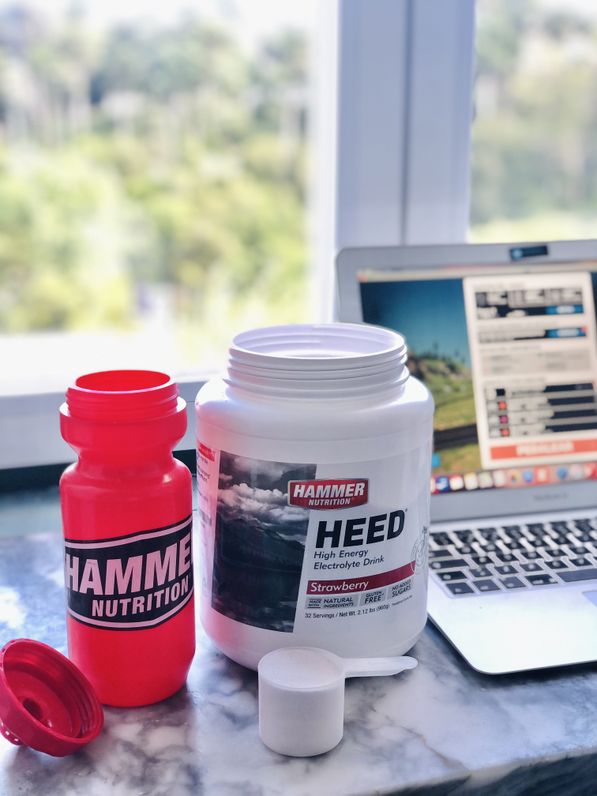
HEED
For athletes who prefer a sports drink over gels, HEED, with its pleasantly mild taste (unlike the typical sports drink), fits the bill perfectly and does so without resorting to refined sugars or artificial colors, flavors, or sweeteners. You won’t find any of these unwanted ingredients in HEED, but you will find a full–spectrum electrolyte profile and key auxiliary nutrients such as l–carnosine for lactic acid buffering and antioxidant support, and chromium polynicotinate for maintaining stable blood glucose levels. For events up to two hours, perhaps slightly longer on occasion, a bottle or two of HEED can cover all of your calorie and fluid requirements, plus at least a portion of your electrolyte requirements. To add variety to your menu, use HEED as a part-time fuel during long-distance events.
HEED's UNIQUE & HEALTHY SWEETENERS
One of the first things people notice when trying HEED for the first time is that it is noticeably less sweet than the typical sports drink. HEED was intentionally designed that way because the overwhelming majority of the athletes we talked to told us that they were sick and tired of trying to choke down an overly sweet, syrupy tasting drink. The secret to how we’re able to make a drink that’s short on overt sweetness but not deprived of calories is in the sweeteners we use — xylitol and stevia, both undeniably healthier alternatives to the simple sugars and/or artificial sweeteners contained in most sports drinks.
-
Xylitol – If there’s such a thing as a perfect sweetener, xylitol is at or near the top of the list. Xylitol is a natural substance that can be found in a variety of fibrous fruits and vegetables. It is also known as birch sugar, primarily because it is usually extracted/produced from birch trees (though it can also be extracted/produced from corn cobs). The human body naturally produces over 15 grams of Xylitol every day by way of normal metabolic processes. Xylitol is used as a sweetener in HEED; it contributes less than 5% of the calories. Xylitol also promotes oral health, as it does not ferment and support the acid–producing bacteria that cause tooth decay. That’s why you’ll find this unique sweetener in gum, toothpaste, and mouthwash, and it’s one of the reasons why we include it in HEED.
-
Stevia – Another ideal natural sweetener is the extract (steviosides) from the leaves of Stevia rebaudiana, a plant native to subtropical and tropical Central and South America. Stevia's sweet taste, considered to be up to 300 times sweeter than sugar, means that minimal amounts are necessary to sweeten a product. Stevia is non–caloric and does not affect blood sugar levels, therefore it is safe for diabetics. Like xylitol, stevia does not support acid–producing bacteria responsible for tooth decay.
HEED is currently available in four refreshing and pleasant-tasting flavors—lemon, lime, mandarin orange, strawberry, and mild melon (all naturally flavored, of course)—and in an unflavored version as well. Hammer Gel currently comes in nine flavors: orange, banana, raspberry, apple cinnamon, Montana huckleberry, chocolate, vanilla, espresso, and tropical. The latter two are the only caffeinated flavors; espresso contains 50 mg of caffeine per serving, tropical contains 25 mg of caffeine per serving.
COMPARING HAMMER GEL AND HEED
-
HEED contains a full spectrum amino acid–chelated electrolyte profile; two servings (scoops) equal approximately 1.25 capsules of Endurolytes. Hammer Gel contains negligible amounts of sodium chloride and potassium for digestive and preservative purposes.
-
HEED contains ChromeMate™ brand chromium polynicotinate for stabilizing blood glucose levels, and l–carnosine for lactic acid buffering. Hammer Gel does not have these.
-
Hammer Gel is a concentrated complex carbohydrate gel with the consistency of syrup. HEED is a powdered sports drink mix.
-
Hammer Gel contains a small amount of the amino acids l–leucine, l–isoleucine, l–valine (known as branched chained amino acids, or BCAAs), and l–alanine. BCAAs help preventing the cannibalizing of lean muscle tissue. L–alanine aids in carbohydrate metabolism. HEED does not contain any BCAAs or l–alanine.
CARB/PROTEIN FUELS
As explained in other articles in The Guide, on most occasions any exercise beyond about two hours requires a protein component in the fuel to satisfy the 5 – 15% of your energy requirements. During these times, if your fuel doesn’t include some protein, your body has only one other source to obtain the amino acids it needs: your lean muscle tissue. You don’t want your body to digest its own muscle just to make fuel—you’d be burning up your own engine! However, if your fuel doesn’t contain some protein, that will happen, leading to negative consequences both during and after your training session or race.
The Hammer line features two carb/protein long-distance fuels, Sustained Energy and Perpetuem. Though the two have somewhat different formulations, primarily the addition of lysolecithin and sodium phosphate in Perpetuem, they are essentially interchangeable and intended to be used as your primary or sole fuel when exercise goes beyond two hours. Many ultra-endurance athletes use both fuels during extreme races, alternating to provide variety in their fueling menu.
Sustained Energy
This is our time–tested standard fuel for extended exercise, first introduced in the early 90’s. Sustained Energy contains about 87% carbohydrates (from maltodextrin and glucose polymers—no added simple sugars, of course), and about 13 % isolated soy protein (7:1 ratio). “SE,” as it’s commonly referred to, remains a fueling staple for thousands of endurance athletes.
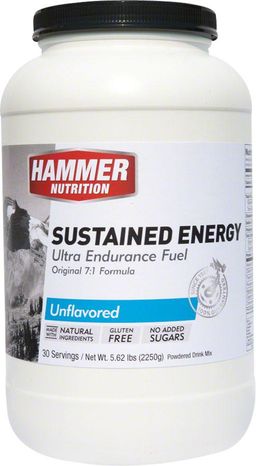
Perpetuem
This product, introduced in early 2003, takes the concept of long-distance fueling to the max. Though many athletes use Perpetuem for shorter distance events (which is perfectly acceptable), we designed it primarily for extreme endurance events lasting several hours to many days. Perpetuem contains 75% carbohydrates (from long-chain maltodextrins—no added simple sugars), 13% fatty acids from a specially made long–chain lysolecithin, and nearly 10% soy protein. A small portion of fat seems to cue your body to more liberally release its fatty acids stores, which account for up to two–thirds of one's energy requirements in long bouts of exercise. A little fat in the fuel also slightly slows the rate of digestion and thus promotes “caloric satisfaction,” another attractive plus during primarily aerobic ultra-distance events.
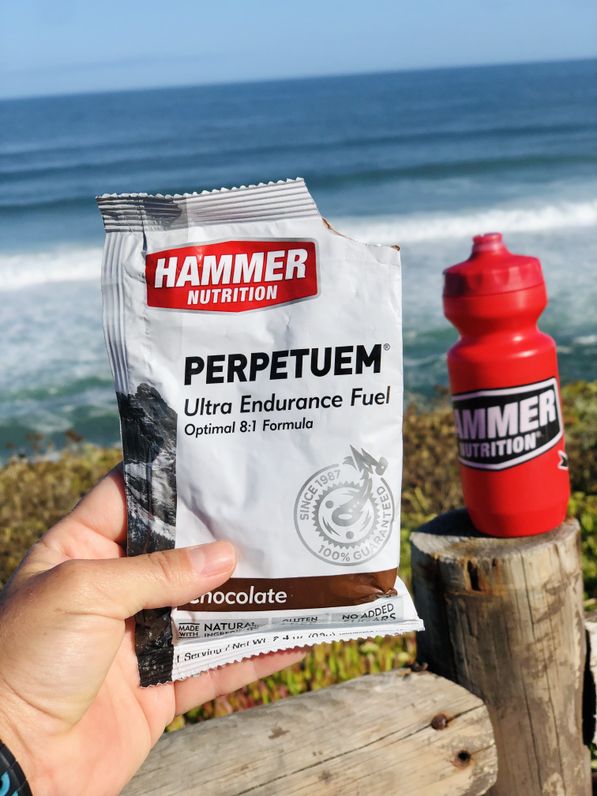
COMPARING SUSTAINED ENERGY AND PERPETUEM
-
Sustained Energy is neutrally (a.k.a. “plain”) flavored. Perpetuem is available in five options: an orange-vanilla "Dreamsicle" flavor, a caffeinated caffe latte flavor (12.5 mg of caffeine per scoop), strawberry–vanilla, chocolate, and an unflavored/plain version.
-
Perpetuem contains lysolecithin fat, whereas Sustained Energy does not.
-
Perpetuem contains tribasic sodium phosphate, which is a tremendous lactic acid buffer. Sustained Energy does not contain this nutrient.
Both fuels contain l–carnosine (an antioxidant that also buffers lactic acid), l–carnitine (to promote fatty acid utilization), and chromium polynicotinate (to support healthy blood sugar levels).
Bottom Line
With Sustained Energy and Perpetuem, you have two great long distance fuel choices. When exercise goes beyond about two hours, you can use either product as your primary or sole fuel, in any combination with each other or any other Hammer Nutrition fuel.
That said, we have noted that Sustained Energy may be the ideal fuel choice when endurance exercise intensity is at a higher level (approximately 70–85% MHR), whereas Perpetuem may be a more attractive choice the longer the athlete goes and when exercise intensity is at a more aerobic pace (under 70% MHR). Additionally, over the years we have noted that Sustained Energy may be the ideal choice for very lean athletes (the “high metabolizer/hypermetabolic” types), while Perpetuem—with its added healthy fat component—may be the ideal choice for athletes with a naturally higher body fat percentage. The rationale for this suggestion is that athletes with a higher body fat percentage have a greater volume of calories available from body fat stores, which the lysolecithin component of Perpetuem may effectively assist in accessing for use as energy.
Again though, because the applications for Sustained Energy and Perpetuem are identical, either fuel can be used as the primary–to–sole fuel during prolonged bouts of exercise. Test each product in your long-duration workouts, under a variety of conditions, to find which product works best for you!
IMPORTANT FAQ's REGARDING SUSTAINED ENERGY AND PERPETUEM
By design, neither Sustained Energy nor Perpetuem contain any artificial preservatives. Preservatives provide absolutely no benefits for athletic performance or general health—we consider them health hazards, in fact—which is why we do not include them in either of these products or any of the Hammer Nutrition powdered fuels.
As a result of this, however, once mixed in solution the protein component in both Sustained Energy and Perpetuem is affected in the following ways:
-
At some point in time it will eventually sour and no longer be acceptable for consumption.
-
It tends to separate after a while and may settle on the bottom of a bottle or hydration pack bladder.
How soon after I make Sustained Energy or Perpetuem do I have to drink it?
Ideally, it should be within 3–5 hours, with up to perhaps 6–8 hours (depending on the temperature) being the longest we recommend. Dr. Bill Misner explains:
Energy drink powders (such as Sustained Energy and Perpetuem) contain no preservatives and are predisposed to change when in solution. Time, temperature, humidity, environmental airborne or endogenous microbes, and/or oxidation factors may cause fatty acids to turn rancid or proteins to "sour" in the presence of long chain or short chain carbohydrates. A prime example is found in pasteurized milk. Milk typically sours in stages as one type of bacteria is replaced by another. Bacilli convert protein into ammonia products, and the pH rises. The odor or taste of spoiled milk is apparent once this has happened. We have observed this phenomenon in our soy–based products, Sustained Energy and Perpetuem, if the product is mixed prior to an event, then not kept cold or consumed within 3–5 hours.
Athletes should be encouraged to keep pre–mixed protein–enhanced or lipid–containing carbohydrate drinks under 59° F (15° C) or ideally at a cooler 40–45° F (approx 4.5 — 7.25° C) in order to keep fermentation of environmental bacteria from proliferating in the drink mixture. Freezing the drink the night before an event may result in keeping the macronutrient contents intact and inhibit bacterial growth potential. Once the drink is soured to taste or has become noxious to olfactory sensed odor, then it is advised that the drink not be consumed.
If I mix Sustained Energy or Perpetuem and keep it in the refrigerator for a day or two, will it break down any of the desired properties due to sitting for a while and not being used right away?
The effectual benefits ("desired properties") are not lost, but the l–carnitine in both products may deteriorate somewhat, forming crystals within the mix since it is very hygroscopic (has an affinity for water). The deterioration, if any, is minimal in 48 hours post–mix, refrigerated. However, for best results we recommend using Sustained Energy or Perpetuem as soon as possible after mixing.
Can I use Sustained Energy or Perpetuem in a hydration pack?
A: You could, but we don't recommend this practice. First, neither Sustained Energy nor Perpetuem contain any preservatives, and as a result, the protein component tends to separate after awhile and may settle on the bottom if the mixture is not agitated on occasion. Keeping a carbohydrate/protein fuel thoroughly mixed can be difficult to do when using a hydration pack. Also, when you mix the product in a water bottle, you're better able to see exactly how much you're consuming. Lastly, cleaning the bladder of any hydration pack is substantially easier when you use it for drinking water only. Our recommendation is to use water bottles to mix Sustained Energy and Perpetuem and hydration packs for water only.
I'm doing a full iron–distance triathlon, and the weather is going to be hot. I want to use Perpetuem for the bike portion. How do you suggest I mix it so that it doesn't get warm and unpalatable?
A: Let’s say that the bike portion will take you six hours. You can make all six hours of fuel in two bottles. For example, if you have found (through testing in training) that two scoops of Perpetuem will provide an hour’s fuel, put six scoops in and make a 3–hour bottle, fulfilling your hydration requirements with plain water (approx 20–28 fluid ounces/600–830 milliliters per hour) from another bottle or hydration system. Make two 6–scoop bottles and you’ve got your six hours worth of fuel taken care of.
Mix the bottles the night before the race and freeze them. That will keep them cold and palatable as they thaw during the bike portion of the race. If, however, the weather on race day is going to be very hot, or you don’t have a way to keep the bottles cold until the bike leg, then try this method: mix and freeze one bottle as above, but in the other put only the six scoops of Perpetuem, and add no water. When you finish your first 3–hour bottle you will need to stop and take a few moments to add cold water to the second bottle. It just takes a few seconds, but now you have a fresh, cold bottle of fuel for the second half of the bike ride. Using insulated bottles also helps, if you don’t mind the slight extra weight.
One athlete who completed a hot–weather Ironman Australia used this method and wrote to us saying, “I did as you recommended — had the second bottle of dry Perpetuem powder in my bike Special Needs bag, and just added cool water. It only took 30 seconds or so and I was underway with a bidon of cold Perpetuem for the second half of the bike. Great suggestion, it works like a treat!”
ENERGY/MEAL REPLACEMENT BAR
Hammer Bar
– For a pre-exercise meal, post-workout/race recovery food, or healthy snack any time, you’d be hard-pressed to find a healthier, yet more convenient food than the Hammer Bar. Additionally, when solid food is desired on occasion during extended workouts and races, the Hammer Bar is an ideal choice, one that complements the other Hammer Nutrition fuels perfectly. At 220–230 calories per bar, the suggested use for most athletes is one–half to one bar/hour (as an occasional replacement for your liquid fuel mixes).
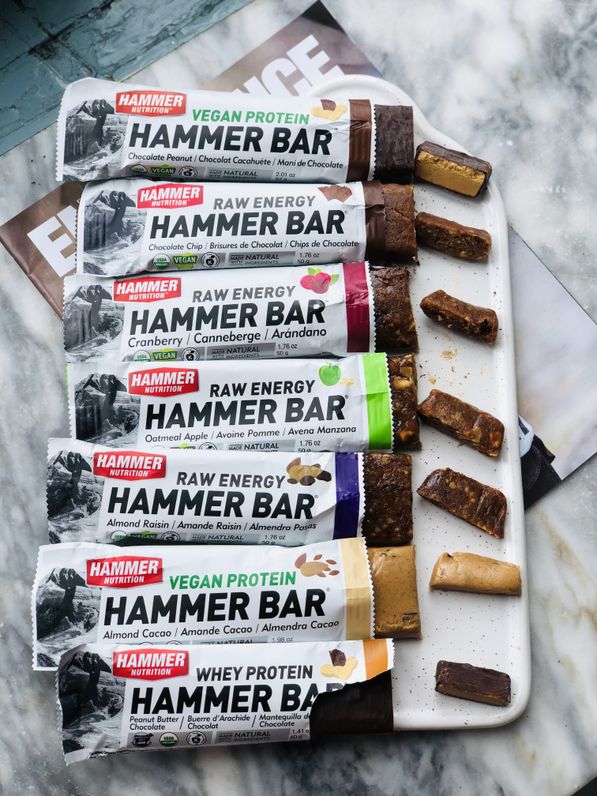
Hammer Bars, available in chocolate chip, cashew coconut chocolate chip, and almond raisin flavors, are moist, and easy to chew and digest. More importantly, they’re gluten–free, USDA Certified Organic, and non–dairy Certified Kosher. The almond raisin Hammer Bar is also Certified Vegan.
Hammer Bars are an extraordinarily healthy food, not just a mere energy bar. This is partly because of what the Hammer Bar does not contain: refined sugar, saturated fats, and artificial sweeteners or preservatives, which many other energy bars are loaded with. As to what the Hammer Bar does contain, here are a few components that let you know you're consuming an ultra–healthy food that just happens to come in the convenience of a bar:
-
Alkalizing protein, crucial for reducing the acidity in the body that comes from sustained energy output. This translates into potentially greater endurance and is achieved by using whole food sources, which are naturally healthier.
-
Healthy carbohydrates for consistent, reliable, and long–lasting energy. Furthermore, the Hammer Bar is sweetened only with whole–food sweeteners, including organic dates, organic raisins, and low Glycemic Index organic agave nectar to support stable blood sugar levels.
-
Essential Fatty Acids (EFAs). Rich in ultra–healthy EFAs, phytosterols, and sterolins, the Hammer Bar is a deliciously easy way to supply your body with these all–important nutrients.
-
Nature's super foods, in the forms of sprouted flax and quinoa, Hawaiian spirulina, and wheat and barley grass juice, to provide phyto–nutrients to support overall health, and proper immune system function.
-
Enzymes, which help the body digest the Hammer Bar and utilize its nutrients at a cellular level. In fact, the Hammer Bar is made fresh in small lots and stored at room temperature to preserve the natural qualities and enzyme activity of the ingredients.
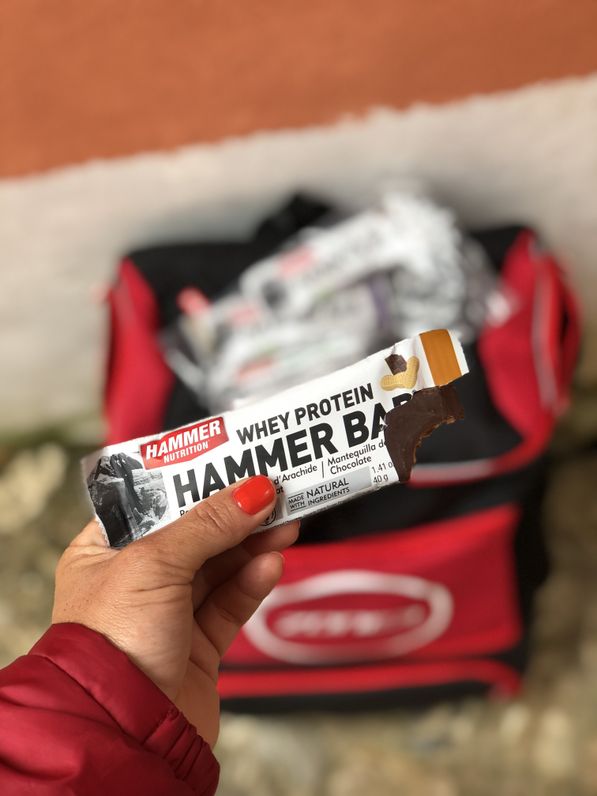
When a solid food choice is desired during a prolonged workout or race, Hammer Bar satisfies your hunger in ideal fashion without excess calories. After workouts or races, if solid food is desired, or when the use of Recoverite is not practical, the Hammer Bar is a superb post–workout/race food, providing high quality carbohydrates and protein in an ideal 3:1 ratio.
ELECTROLYTES
Endurolytes – A full–spectrum, rapidly assimilated electrolyte supplement is as important to your fueling as the water you drink and the calories you eat. While the earlier–listed fuels provide the calories that your body needs to make energy (the body’s “gasoline”), electrolytes can be thought of as the “motor oil” for the body, providing it with the essential minerals it needs to maintain the optimal performance of many important functions, such as muscular contraction.
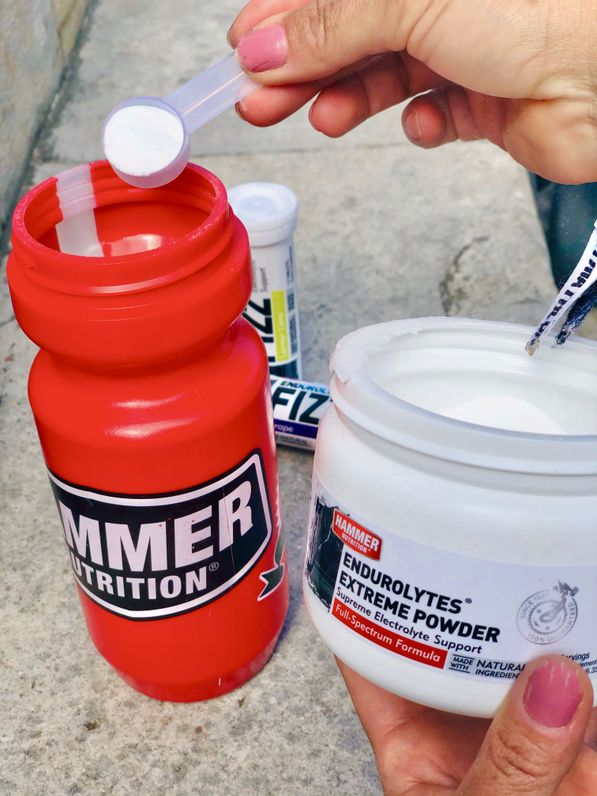
Far too many athletes forget to replenish electrolytes consistently, or they mistake sodium or salt intake for true electrolyte replenishment. Sodium chloride (salt) is indeed an important component of electrolyte replenishment, but it does not fulfill the entire requirement. A satisfactory electrolyte replenishment product needs to include balanced amounts of sodium, chloride, calcium, magnesium, and potassium, as all these minerals work synergistically in the maintenance of these important body functions. Endurolytes is that product, and you will search in vain to find one like it on the market.
Many variables—body weight, level of fitness, weather conditions, acclimatization level, and biological predisposition—come into play in regards to optimally fulfilling one’s personal electrolyte requirements. That’s why you want to meet most or all of your electrolyte needs from a source independent of your fuel. These many variables are also why the hourly Endurolytes dose can range from 1–6 capsules an hour, with a handful of athletes requiring up to 7–8 capsules an hour under extreme conditions. All of this said, a good starting dose to consider is:
-
Lighter weight athletes: 1–2 capsules/hour
-
Medium weight athletes: 2–3 capsules/hour
-
Larger athletes: 4–6 capsules/hour
Remember though, these are only suggested starting doses and the amount you need may be different and may vary from hour to hour.
PROTEIN POWDERS
You will not use these two products during your workouts, but as part of your pre–workout meals and post–workout recovery refueling. Hammer Nutrition offers two choices, each with its own set of benefits. Both products come in pure protein form; they are made from the finest quality preparations, and have no added artificial flavorings or sweeteners.
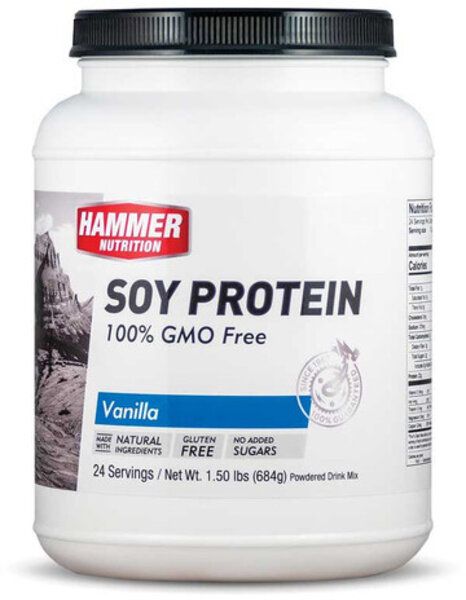
Hammer Soy – A great all–purpose, all–vegetable protein that has many health benefits. Believe it or not, most endurance athletes have woefully inadequate protein intakes from their daily diet. Soy protein, in addition to the health benefits it provides, is a concentrated protein source, which helps athletes to fulfill their daily protein requirements. Each scoop of Hammer Soy contains 25 grams of isolated soy protein and absolutely no GMO (genetically modified organism) soy protein.
Note: Soy is the preferred protein for use during exercise, as it minimizes ammonia build–up. Sustained Energy and Perpeteum contain an adequate amount of soy protein for your needs during prolonged exercise. Hammer Soy is formulated for meal supplementation; it is far too concentrated for use during exercise.
Hammer Whey – The standard for promoting rapid recovery. For rebuilding lean muscle tissue and optimal immune system functioning between workouts and races, whey protein has no peer. It is the most bioavailable form of protein with the highest amount of branched chain amino acids (BCAAs) of any protein. One scoop of Hammer Whey provides 18 grams of whey protein isolate. Each scoop also contains a huge six grams of glutamine, providing even more muscle rebuilding and immune system enhancing benefits. Hammer Whey Protein comes from grass-fed cows and is rBGH-free and anitbiotic-free.
We believe you'll not find a better protein for recovery and immune system boosting than whey protein (Hammer Whey), and for cardiovascular/general health benefits it's hard to top soy protein (Hammer Soy). That doesn't mean using Hammer Soy for recovery purposes would be "wrong" or in any way harmful, or that Hammer Whey must be used solely for recovery (but we don’t recommend using it within three hours prior to or during exercise).
-
Whey protein is arguably the most rapidly absorbed protein source. After exercise, you want the protein to get into your system immediately so that your body can receive the amino acid support it urgently needs. Rapid assimilation is but one area where whey protein shines.
-
Whey protein has the highest BV (Biological Value, a rating system that ranks bioavailability) of any protein source.
-
Whey protein's amino acid profile (particularly the high amounts of BCAAs) is superb for preventing catabolism (lean muscle tissue breakdown) and thus reducing post–workout muscular soreness. The amino acids cysteine, methionine, and glutamine, also found in abundance in whey, increase endogenous levels of glutathione, which is arguably the strongest endogenous antioxidant and provides both immune system and liver support.
-
Soy protein is a purely vegan source that has an amino acid profile as complete as any animal protein.
-
Soy has more phenylalanine than whey. This may aid in maintaining alertness during extreme ultra–distance races.
-
Soy has higher amounts of histidine (half of the dipeptide carnosine), which provides both antioxidant and acid buffering benefits.
-
Soy protein has higher levels of aspartic acid, which plays an important role in energy production via the Krebs cycle.
-
Soy protein's isoflavone component may impart exceptional cardiovascular benefits.
Hammer Whey is currently available in two pleasant tasting flavors—chocolate and vanilla (both naturally flavored, of course)—and in an unflavored version, as well. Hammer Soy is currently available in an unflavored version.
RECOVERY DRINK
Recoverite – The delicious all–in–one recovery drink with each serving (two scoops) providing 30 grams of complex carbohydrates, 10 grams of whey protein isolate, and three grams of glutamine. While the standard 4:1 carbohydrate to protein ratio is certainly acceptable for recovery, a 3:1 ratio may be even more beneficial for hard training athletes.

Special features of Recoverite
-
Recoverite contains whey protein isolate, which is 97–98+% protein, whereas whey protein concentrate (which is what many companies use) is only 70–85% protein (and oftentimes less). Whey protein isolate is a purer protein, and the best protein that you can put into your body after a hard workout. Hammer Whey Protein comes from grass-fed cows and is rBGH-free and anitbiotic- free.
-
Recoverite contains complex carbohydrates, no simple sugars. Granted, the one time when your body isn’t going to put up much of a fight about what kind of carbs you consume is right after a workout; it’s so starving for replenishment that it’ll take pretty much anything. That being said, complex carbohydrates are still preferable to simple sugars for two primary reasons:
-
While some companies may use monosaccharides and disaccharides (simple sugars) such as glucose or dextrose in their recovery drinks, due to their high glycemic index (GI) (and thus fast elevation of blood sugar), the maltodextrin used in Recoverite has a GI that's even higher than these simple sugars, so it also elevates blood sugar levels rapidly.
-
Complex carbohydrate maltodextrins allow for a greater volume of calories to be absorbed compared to simple sugars. This is vital for preventing stomach distress and also ensuring that your body quickly and efficiently obtains the full amount of calories it needs.
-
Recoverite contains high amounts of glutamine. Taking straight glutamine isn’t recommended during exercise due to the ammonia that is produced during digestion. After exercise, however, it’s a powerfully beneficial nutrient for immune system support and glycogen replenishment. Each serving of Recoverite gives you a superb 3–gram (3000 mg) dose of this vital amino acid.
-
Recoverite has a mild taste. If you’re like most athletes, the last thing that you want after a long workout is a syrupy textured, coat–your–mouth–with–sweetness drink. Recoverite—available in three delicious flavors: subtle citrus, strawberry, and chocolate—provides the nutrition that your body craves, with the additional benefit of a substantially milder taste.
FUELING NOTES
-
The fuel selection guidelines that follow are just that; they’re guidelines only, and what may be ideal for some athletes under specific conditions may not work for others in identical situations. For example, though Perpetuem was designed for more aerobic paced, longer distance efforts, we receive positive reports daily from athletes who use Perpetuem in much shorter races.
-
All Hammer Nutrition fuels are completely compatible with one another, so you can use them interchangeably as desired. This is especially beneficial in ultra–endurance events as it provides a greater variety of quality fuels to choose from. For example, you can use Perpetuem and/or Sustained Energy from start to finish, or you can occasionally switch to HEED and/or Hammer Gel to add variety. However, during prolonged workouts or races you should fulfill at least two–thirds of your fueling requirements from Perpetuem or Sustained Energy.
-
When you use Hammer Gel and HEED for events longer than two or so hours, you do not need to start with them and then switch to Sustained Energy or Perpetuem at the 90–120 minute mark, when protein plays a more predominant role in satisfying fueling requirements. You can use Hammer Gel and/or HEED at any time during your workout. An extra flask of Hammer Gel in your pocket can save the day if you have already drained your Sustained Energy or Perpetuem mix and you begin to flag with several miles still to go. It will give you a quick pick–up just when you need it, even if it’s many hours into your event.
USAGE SUGGESTIONS
Key things to remember regarding fueling
#1 - The goal in fueling is not to try and replace all the calories your body is burning with equal to near–equal amounts from your fuel. As explained in various articles found in The Endurance Athlete’s Guide to Success (PDF/4 MB), and in back issues of Endurance News, the human body is not equipped to replace “X” out with “X” or “near–X” in. Fortunately, the body has many built–in mechanisms that effectively bridge the gap between what it’s losing and what it can comfortably accept in return from your fuel donation. That’s why your focus should NOT be “How many calories can I consume before I get sick?” but rather, “What is the least amount of calories I need to consume to keep my body doing what I want it to do hour after hour?”
Fueling this way—the “less is best” approach—makes much more sense, if only because a “not enough calories” problem is significantly easier to fix (you simply consume more calories) than an “uh oh, I overdid it on the calories” problem.

#2 - During exercise, the average–size athlete’s liver can effectively return 4.0 to slightly over 4.6 calories per minute back to the energy cycle. That's 240 – 280 calories per hour MAXIMUM for the average–size athlete under normal conditions. However, we have consistently noted that most athletes do well on even fewer calories, so "average size" athletes (approximately 160–165 lbs/approx 72.5–75 kg) should look at that 240 – 280 gauge only as a reference point (you’ll notice that our recommendations are even less than those amounts). Of course, larger athletes on occasion may need slightly more calories and lighter athletes will most certainly need fewer calories.
Larger athletes on occasion may need slightly more calories, lighter athletes will most certainly need fewer calories, and "average size" athletes (approximately 160–165 lbs/approx 72.5–75 kg) should use the 240 – 280 gauge as a starting point, if not lower.

3# - All athletes must be willing to alter their calorie intake in deference to the weather, the terrain, their pace, and any pre–race anxieties they're experiencing, as all of these things negatively affect optimal digestive system functioning.
With this in mind, here are our suggested dosages for the following Hammer Nutrition fuels. As just mentioned, over the years we have consistently noted that for optimal performance most athletes require far less than the theoretical maximum of 240–280 calories/hour. This is why we recommend starting with the lowest amount suggested, especially if your weight is at the lower end of the scale, and increase the amount of calories you consume if you find it necessary.

Remember, though, that these are just suggestions and that you need to determine, via thorough testing under a variety of conditions, what amounts work best for you.
Hammer Gel (90 — 100 calories per serving, depending on flavor)
Suggested Doses by Body Weight*:
-
0 – 120 lbs (approx 54.5 kg) – up to 1 serving /hr. This provides up to 90–100 calories.
-
120–155 lbs (approx 54.5–70 kg) – 1 to 2 servings/hr. This provides 90–100 to 180–200 calories.
-
155–190 lbs (approx 70–86 kg) – 2 to 2.5 servings/hr. This provides 180–200 to 225–250 calories.
-
190+ lbs (86+ kg) – up to 3 servings/hr. This provides 270–300 calories.
*These are estimated doses. Each athlete should determine in training, under a variety of conditions, their personal optimum.
Usage Suggestions & Notes:
-
Hammer Gel may be used as your sole energy source during workouts and races up to two hours, perhaps up to three hours under certain circumstances. When training sessions or races go longer than that, select either Perpetuem or Sustained Energy as your primary fuel.
-
Hammer Gel is perfectly compatible with all Hammer Nutrition fuels, so during ultra distance events, while Hammer Gel cannot be your sole source of calories, you can use it occasionally to provide a little variety.
-
The Hammer flask holds 5–6 servings.
-
Hammer Gel flavors can be mixed for a variety of tastes. Try these combinations:
-
Banana + Chocolate or Espresso = Banana Split
-
Orange + Vanilla = Orange Creamsicle
-
Raspberry + Orange + Banana = Fruit Punch
-
Raspberry + Espresso = Raspberry Mocha
To make a super high quality, easily digested, and great tasting recovery drink, mix 2–3 servings of Hammer Gel with 1.25 scoops of Hammer Whey in 4–8 ounces (approx 118–236 ml) of cold water.
HEED (105 calories per scoop)
Suggested Doses by Body Weight*:
-
0 – 120 lbs (approx 54.5 kg) – up to 1 scoop/hr. This provides 105 calories.
-
120–155 lbs (approx 54.5–70 kg) – 1 to 1.5 scoops/hr. This provides 105 to 157.5 calories.
-
155–190 lbs (approx 70–86 kg) – 2 to 2.5 scoops/hr. This provides 210 to 262.5 calories.
-
190+ lbs (86+ kg) – up to 2.75 scoops/hr. This provides approx 289 calories.
0 – 120 lbs (approx 54.5 kg) – up to 1 scoop/hr. This provides 105 calories.
120–155 lbs (approx 54.5–70 kg) – 1 to 1.5 scoops/hr. This provides 105 to 157.5 calories.
155–190 lbs (approx 70–86 kg) – 2 to 2.5 scoops/hr. This provides 210 to 262.5 calories.
190+ lbs (86+ kg) – up to 2.75 scoops/hr. This provides approx 289 calories.
*These are estimated doses. Each athlete should determine in training, under a variety of conditions, their personal optimum.
Usage Suggestions & Notes:
-
HEED may be used as the sole source of calories during workouts and races up to two hours, perhaps up to three hours under certain circumstances. When training sessions or races go longer than that, select either Perpetuem or Sustained Energy as your primary fuel source.
-
HEED is perfectly compatible with all Hammer Nutrition fuels, so during ultra distance events, while it cannot be your sole source of calories, you can use it occasionally to provide a little variety.
-
Each scoop of HEED contains the equivalent amount of electrolytes and approximately 2/3 of an Endurolytes capsules. For many athletes, under normal conditions, one or two scoops of HEED will completely fulfill electrolyte requirements. When heat stress increases significantly, you will need to consume additional Endurolytes.
-
To make a high quality, easily digested, and great tasting recovery drink, mix 3 scoops of HEED with 1.5 scoops of Hammer Whey in 4–8 ounces (approx 118–236 ml) of cold water.
Sustained Energy (approximately 107 calories per scoop)
Suggested Doses by Body Weight*:
-
0 – 120 lbs (approx 54.5 kg) – up to 1 scoop/hr. This provides 107 calories.
-
120–155 lbs (approx 54.5–70 kg) – 1 to 1.5 scoops/hr. This provides 107 to 160.5 calories.
-
155–190 lbs (approx 70–86 kg) – 2 to 2.5 scoops/hr. This provides approx 214 to 267.5 calories.
-
190+ lbs (86+ kg) – up to 2.75 scoops/hr. This provides approx 294 calories.
0 – 120 lbs (approx 54.5 kg) – up to 1 scoop/hr. This provides 107 calories.
120–155 lbs (approx 54.5–70 kg) – 1 to 1.5 scoops/hr. This provides 107 to 160.5 calories.
155–190 lbs (approx 70–86 kg) – 2 to 2.5 scoops/hr. This provides approx 214 to 267.5 calories.
190+ lbs (86+ kg) – up to 2.75 scoops/hr. This provides approx 294 calories.
*These are estimated doses. Each athlete should determine in training, under a variety of conditions, their personal optimum.
NOTE: See mixing options below
Perpetuem (135 calories per scoop)
Suggested Doses by Body Weight*:
-
0 – 120 lbs (approx 54.5 kg) – up to 3/4 scoop/hr. This provides approximately 101 calories.
-
120–155 lbs (approx 54.5–70 kg) – 1 scoop/hr. This provides 135 calories.
-
155–190 lbs (approx 70–86 kg) – 1.25 to 1.5 scoops/hr. This provides approx 169 to 202.5 calories.
-
190+ lbs (86+ kg) – up to 2 scoops/hr. This provides 270 calories.
0 – 120 lbs (approx 54.5 kg) – up to 3/4 scoop/hr. This provides approximately 101 calories.
120–155 lbs (approx 54.5–70 kg) – 1 scoop/hr. This provides 135 calories.
155–190 lbs (approx 70–86 kg) – 1.25 to 1.5 scoops/hr. This provides approx 169 to 202.5 calories.
190+ lbs (86+ kg) – up to 2 scoops/hr. This provides 270 calories.
*These are estimated doses. Each athlete should determine in training, under a variety of conditions, their personal optimum.
Special Note on Perpetuem: Due to this being a high concentration calorie source (via its complex carbohydrate, soy protein, and healthy fat components), we have noted that many athletes do well with a substantially lower calorie intake when using Perpetuem as their primary–to–sole fuel. Therefore, with this particular fuel we highly recommend starting with the lowest amount suggested—perhaps even a bit lower—and work your way up to a higher amount, if a higher amount has proved to be necessary via testing in training.
SUSTAINED ENERGY/PERPETUEM MIXING OPTION
You can mix and consume Sustained Energy or Perpetuem three different ways depending on individual preference and logistical concerns. Please experiment with the following options to determine which works best for you.
-
The One–Hour Bottle – Mix the suggested amount of Sustained Energy or Perpetuem for your bodyweight (refer to dosage charts) in a 21–24 ounce (approx 520–710 ml) water bottle. Consume one bottle hourly. This method is ideal when training or racing with a support crew and vehicle. If you’re without a support crew but still want to use this option for mixing, keep in mind that it’s obviously less convenient as you’ll have to stop more frequently to mix your fuel drink. Also, because you are trying to fulfill both hydration and caloric requirements from one source, you have limited ability to adjust one without affecting the other; you may need to consume additional water to satisfy hydration requirements.
-
The Multi–Hour Bottle – This is by far the most convenient method of fueling because it allows you to be self–sufficient for many hours, requiring only additional plain water along the way. The only limitation is how many scoops you can fit into a bottle. Determine your proper hourly intake of scoops by experimenting with the numbers from the dosage charts. Let’s say you’ve determined through testing that two scoops of Sustained Energy or Perpetuem per hour is your ideal caloric intake. For a four–hour workout, you’ll need eight scoops in a bottle, then filled with water and shaken well. You may need to add a few scoops at a time to get it all to mix well. You then “nurse” this bottle, taking small sips every 15–20 minutes.
At this concentration, the water in the mixed bottle does not contribute much at all to your hourly fluid intake needs. To meet your fluid requirements, you can carry a second and possibly even a third bottle of plain water, use a hydration system, or know where you can refill along your route. Drink according to the temperature/humidity and your exertion level so that you consume in the range of 16–28 ounces (approx 475–830 ml) of plain water per hour.* This way, as long as you can obtain water along the way, you’re set for hours of hard training.
-
Gel or Paste – If you want to carry the highest volume of calories in the least amount of space, making a thick mix is your best option. Sustained Energy or Perpetuem can be made into a super–concentrated, near paste–like consistency and dispensed from a Hammer Gel flask. Using a blender or bowl and spoon, mix scoops of powder with a small amount of water, gradually adding water as necessary to create the consistency desired. If you're using the orange–vanilla flavor of Perpetuem, remember that the heavier and more concentrated you mix it, the sweeter and stronger the flavor will become. You can also add Hammer Gel or HEED for flavor, if desired. Depending on how many scoops per hour you require, and how concentrated the mix is, each flask of Sustained Energy or Perpetuem can supply you with 2–4 hours of fuel. As with the multi–hour bottle, you must carry additional bottles of plain water or use a hydration system to meet your fluid requirements.
POST-WORKOUT FUELING
Recovery begins as soon as the workout ends. The sooner you refill the tank, the quicker your recovery and the better prepped your body will be for the next workout. In other words, how well you recover today greatly determines how well you perform tomorrow. To put the finishing touches on your workouts, and to get the full value out of every minute of your training, make sure that you consume adequate amounts of high quality and easily digested carbohydrates and protein as soon as possible after each of your training sessions. Recoverite is the ideal and convenient way to fulfill this all–important component of athletic fueling.
Recoverite (85 calories per scoop)
Suggested Doses by Body Weight*:
-
Up to 120 lbs (approx 54.5 kg) –– 1.5 to 2 scoops. This provides 127.5 – calories
-
120–190 lbs (approx 54.5–86 kg) ––2 to 2.5 scoops. This provides 170 – 212.5 calories
-
190+ lbs (86+ kg) –– 3 or more scoops. Three scoops provide 255 calories
Up to 120 lbs (approx 54.5 kg) –– 1.5 to 2 scoops. This provides 127.5 – calories
120–190 lbs (approx 54.5–86 kg) ––2 to 2.5 scoops. This provides 170 – 212.5 calories
190+ lbs (86+ kg) –– 3 or more scoops. Three scoops provide 255 calories
* Obviously, a 110–lb/50–kg athlete requires far less after an easy two–hour run than a 190–lb (approx 86 kg) athlete who just crunched an Ironman–length event. How much Recoverite one should use is based on a couple of factors:
-
The body weight of the athlete
-
The duration and/or severity of the workout or race
-
When the next opportunity for a "real food/sit–down" meal will be
When you factor those things in it'll help you determine how much Recoverite you'll want to use.
Conclusion:
You’re already investing heavily into your sport; make sure that your fuel allows you to reap the full benefits of all that you’re investing. Aside from water, which of course you will need to supply, Hammer Nutrition has everything that you need to cover your fueling requirements prior to, during, and after exercise. With Hammer Nutrition’s line of fuels, you can focus on your training and racing and NOT have to worry about whether or not your fuel is going to come up short energy–wise, or literally come back up. You’ve got better things to think about than that and we guarantee that with Hammer Nutrition fuels you won’t have to worry about fuel–related problems anymore. In fact, we guarantee that when you use Hammer fuels you’ll experience better quality workouts and race performances. Give Hammer Nutrition fuels a try today—starting with our recommendations listed earlier and fine-tuning them in your training—and see how good you’ll feel when you fuel your body right.







